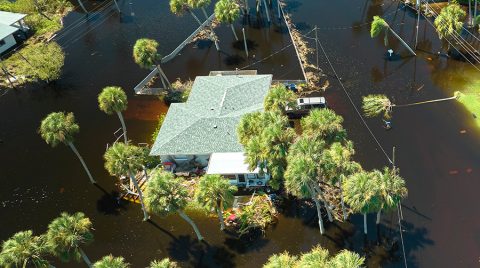-
Schaden & Unfall
Schaden & Unfall ÜberblickRückversicherungslösungenTrending Topic

Schaden & Unfall
Wir bieten eine umfassende Palette von Rückversicherungslösungen verbunden mit der Expertise eines kompetenten Underwritingteams.
-
Leben & Kranken
Leben & Kranken ÜberblickUnsere AngeboteUnderwritingTraining & Events

Leben & Kranken
Wir bieten eine umfassende Palette von Rückversicherungsprodukten und das Fachwissen unseres qualifizierten Rückversicherungsteams.
-
Unsere Expertise
Unsere Expertise ÜberblickUnsere Expertise

Knowledge Center
Unser globales Expertenteam teilt hier sein Wissen zu aktuellen Themen der Versicherungsbranche.
-
Über uns
Über uns ÜberblickCorporate InformationESG bei der Gen Re

Über uns
Die Gen Re unterstützt Versicherungsunternehmen mit maßgeschneiderten Rückversicherungslösungen in den Bereichen Leben & Kranken und Schaden & Unfall.
- Careers Careers
Working From Home or Living at Work?

28. Mai 2025
Mary Enslin
English
It has been six years since the World Health Organization (WHO) made headlines after including burnout in the 11th Revision of the International Classification of Diseases (ICD‑11) as an occupational phenomenon.1 Despite WHO emphasising that it is “not classified as a medical condition”, many news outlets and disability advocacy groups incorrectly declared burnout was now an official diagnosis and an official cause of disability.2 The month of May is Mental Health Awareness Month and this year’s theme is “In Every Story, There’s Strength”.3 With this in mind, we thought it timely to take a look at how the world of work has changed and what the current evidence tells us about burnout.
How Do we Define Burnout?
The term burnout is often used casually when someone feels a bit tired at work or overwhelmed by life, but it has clearly defined characteristics. The ICD‑11 places burnout in the chapter: “Factors influencing health status or contact with health services.” There it is defined as “a syndrome conceptualised as resulting from chronic workplace stress that has not been successfully managed. Burnout refers specifically to phenomena in the occupational context and should not be applied to describe experiences in other areas of life”.4
It is characterised by three dimensions:
- Progressive feelings of energy depletion or exhaustion.
- Increased mental distance from one’s job, a loss of motivation or engagement, or feeling disillusioned, negative, or cynical towards work.
- Reduced professional efficacy. This could be perceived as difficulty processing information, making decisions, or working effectively.5
Research suggests there may be differing types of burnout, relating to different types of work environment. Studies have suggested three subtypes:
- “Frenetic”: marked by work overload and often experienced by highly involved, ambitious individuals.
- “Underchallenged”: experienced by those working in roles with no personal development.
- “Worn out”: which occurs in a rigid, hierarchical organisation where workers may have a lack of control or recognition.6
What Causes Burnout?
Burnout is caused by prolonged and excessive stress. In the book The Burnout Challenge,7 the author, Christina Maslach, explains: “Burnout is a stress response to those chronic job stressors. A stress response is a normal human response to threats or challenges, and it’s a good thing usually. That’s how we cope. But recovery is the issue. When you run a marathon, you recover. Chronic job stressors – we liken them to pebbles in your shoes – are the daily things that are always in the way.”
Put another way, the root cause of burnout lies in the chronic over-activation of the stress response, without respite, which pushes our nervous system beyond its ability to recuperate. The Burnout Challenge goes on to identify the following stressors as the most significant risk factors for burnout:
- Increased workload or overworking
- Lack of autonomy or control
- Inadequate reward systems
- A toxic community or negative workplace culture
- Lack of fairness presented by unfair or unethical company practices and policies
- Opposing or conflicting values
Personal aspects may also play a role. These include lifestyle factors such as lack of sleep and poor social support, as well as personality traits such as perfectionism or difficulty giving up control.
What is the Impact of the Changing World of Work?
Burnout is not a modern phenomenon. A Burnt-Out Case, published in 1961, is a novel by Graham Greene about an architect worn down by his job. In 1974, Bob Dylan sang about being “burned out from exhaustion”. Current estimations of the prevalence of burnout differ greatly and there is conflicting evidence as to whether the incidence is increasing or remaining stable relative to working population sizes. What does seem clear is that individuals’ perceived levels of work-related stress and burnout is on the rise. The leading theory is that this is due to post-COVID‑19 changes to our working world.
In 2022, the World Economic Forum8 described the key forces shaping the new world of work. These can be summarised as:
- Remote and hybrid work
- More frequent role and industry changes
- Increased digitisation and incorporation of artificial intelligence (AI)
In addition, changing demographics and values of the workforce have meant that employee wellness offerings, such as gym memberships, home office expenses, and mental health services have increased, and companies seem to be more willing to engage in conversations around burnout.
Intuitively, these changes should help mitigate stressors driving burnout by enabling increased work-life balance, productivity, and wellbeing for employees. However, the emerging data paints a different picture. The combination of remote work and the seamless integration of ever-advancing technological tools has resulted in a blurring of lines between work and leisure and has led to some unhelpful communication habits. Many people report that they have experienced the feeling of being always “on duty” or “always connected”, and many of us may have found ourselves sitting in an online meeting that could have been an email.
Global analysis from WHO and the International Labour Organization concluded that “working long hours is on the increase and is responsible for about one-third of the total estimated work-related burden of disease.”9 Prolonged working hours have been linked to various negative health outcomes, including cardiovascular disease, metabolic disorders and mental health issues, such as depression and anxiety. Further, preliminary research, published just this month in the journal of Occupational and Environmental Medicine, has found that overworked individuals exhibited significant changes in brain regions associated with executive function and emotional regulation, specifically attention, planning, working memory, decision-making, and language-related processing.10
In addition to longer hours, the changing scope of many jobs, combined with the cost-of-living crisis and other economic pressures, drives individuals to strive for more and more productivity.
What Helps?
The world of work will continue to change as we adapt to AI and other emerging trends. What can we do to keep abreast with these changes while preventing burnout in our workforce?
Educate individuals and managers to recognise the signs of burnout as early as possible. These include short-temperedness, irritation with colleagues, frustration with small tasks, or feeling emotionally detached. Working together to identify reasonable accommodations and supportive wellness initiatives can prevent burnout before it becomes debilitating.
Prioritise work-life balance by setting boundaries, carving out time that is free from responsibilities, and seeking joy. Being disciplined about when we stop working can be a challenge but having “normal” working hours, whatever those look like, helps the brain know when to switch off. There may be days when we need to work longer, but these should be the exception. It is important to make time for activities outside of work that bring meaning, health, and relaxation. Building a buffer zone between work and leisure time can help. For many, a physical commute created a natural buffer that told our brains and bodies we were transitioning from work to leisure time. Now with the increase in remote work, we may need to create an artificial commute to serve the same purpose. This “end-of-day routine” could include a short walk, tidying the desk, making tomorrow’s to‑do list, or any ritual that signifies the end of the working day.
Create healthy habits that foster resilience. Embedding wellness breaks – such as short, frequent movement breaks, mindfulness practices, or breathing exercises – into a daily routine can help regulate the nervous system, reduce stress, and improve focus. The importance of quality sleep is an area of increasing research, and the results tell us that the value of adequate rest cannot be overstated. Chronic inadequate sleep negatively impacts our physical and mental health,11 reduces longevity,12 and diminishes cognition, work performance, and productivity.13 Experts suggest winding down before bed by creating sufficient distance between the end of the workday and bedtime.
Switch off screens! Excessive screen time in adults has been linked to a range of negative health outcomes, according to the U.S. Centers for Disease Control and Prevention14 and WHO15. These include increased levels of anxiety, depression and stress, increased sedentary behaviour with associated weight gain and musculoskeletal issues, disrupted melatonin production leading to poor sleep quality, and impaired attention span, memory and executive function.
What Can Employers Do?
It is noteworthy that the above advice does not recommend extended time off work or sick leave as a cure for burnout. Rest alone is rarely helpful, and it is usually better for the affected individual to work with their employer to find solutions. While the above individual strategies can help, they do not change the chronic stressors present in the environment.
As the modern work environment evolves, so too do our beliefs and values about work. Work used to be viewed with a limited lens as a source of income, with most individuals deriving personal meaning and community from friends, families, neighbours, leisure pursuits, religious and political beliefs, and the many other aspects of our personal lives. Now, many demand that work is a place of purpose, providing meaning, community, social life, identify, and more.
Considering this, many studies have emphasized the importance of interventions at the company level.16,17 These include addressing core organisational cultural practices such as working hours, schedules, workload, renumeration, and performance reviews. One study found that the most common factor negatively affecting mental health was emotionally draining (e.g. stressful, overwhelming, boring, or monotonous) work.18
Employer and employee can also work together to set realistic workload expectations, align on values, and offer effective wellness programs that help create a buffer against burnout. Last year during Mental Health Awareness Month we looked at the hallmarks of effective employee wellness programmes, which include physical, mental, financial and social wellbeing. If you want to know more, see All’s Well that Ends Well – Do Mental Health Wellness Programmes Work?
Conclusion
“In every story, there’s strength” – and the story of burnout is no exception. While burnout reflects the toll of chronic, unmanaged stress in the workplace, it also reveals the resilience of individuals striving to meet the relentless demands of modern working life. This empowers us to respond with compassion, awareness and action. Individual strategies such as setting boundaries, prioritising rest, and cultivating resilience are vital, but they must be supported by systemic change. This Mental Health Awarness Month, we encourage you to reflect on how you and your organisation can play a crucial role in reshaping workplace culture, addressing root causes, and fostering environments where wellbeing is prioritised.
- WHO, 2019. Burn-out an “occupational phenomenon”: International Classification of Diseases, https://www.who.int/news/item/28-05-2019-burn-out-an-occupational-phenomenon-international-classification-of-diseases, accessed May 2025
- Prospect.org.uk, 2019, World Health Organisation widens definition of burnout; CNBC.com, 2019, The World Health Organization officially recognizes workplace ‘burnout’ as an occupational phenomenon, https://www.cnbc.com/2019/05/28/who-recognizes-workplace-burnout-as-an-occupational-phenomenon.html; CBSNews.com, 2019, World Health Organization classifies work "burnout" as an occupational phenomenon, https://www.cbsnews.com/news/world-health-organization-classifies-work-burnout-an-occupational-phenomenon-2019-05-28/; independent.co.uk, 2019, ‘Burn-out’ recognised as chronic condition by World Health Organisation, https://www.independent.co.uk/life-style/burnout-world-health-organisation-medical-condition-chronic-stress-a8932806.html. All accessed May 2025.
- National Alliance on Mental Illness, 2025. Mental Health Awareness Month, https://www.nami.org/Get-Involved/Awareness-Events/Mental-Health-Awareness-Month/, accessed May 2025
- Ibid, endnote 1
- Ibid, endnote 1
- Montero‑Marín, J., García‑Campayo, J., Mera, D.M. et al. 2009. A new definition of burnout syndrome based on Farber’s proposal. J Occup Med Toxicol 4, 31. https://doi.org/10.1186/1745-6673-4-31, accessed May 2025.
- Christina Maslach and Michael P. Leiter, 2022. The burnout challenge: Managing people’s relationships with their jobs. Harvard University Press, Cambridge, Massachusetts. From https://www.hup.harvard.edu/file/feeds/PDF/9780674297272_sample.pdf, accessed May 2025
- World Economic Forum, 2022. Future of work: Key takeaways from Davos experts, https://www.weforum.org/stories/2022/05/future-work-jobs-davos-experts/, accessed May 2025.
- The Independent, 2025. ‘Overworking’ may alter our brain structure. Here’s who is at risk, https://www.independent.co.uk/life-style/health-and-families/overworking-employees-signs-brain-long-hours-b2749918.html, accessed May 2025
- Jang, W., Kim, S., Kim, Y., et al, May 2025. Overwork and changes in brain structure: a pilot study. Occupational and Environmental Medicine Published Online First: 13 May 2025. doi: 10.1136/oemed-2025-110057, accessed May 2025
- Harvard Health Publishing, 2024. Sleep, https://www.health.harvard.edu/topics/sleep, accessed May 2025
- Mayo Clinic, 2024. Sleep and longevity: How quality sleep impacts your life span, https://mcpress.mayoclinic.org/healthy-aging/how-quality-sleep-impacts-your-lifespan/, accessed May 2025
- The Sleep Foundation, 2024. Sleep News, https://www.sleepfoundation.org/sleep-news, accessed May 2025
- Center for Disease Control, 2024. Call for Papers, Screen-Time Effects on Mental Health, Physical Activity, Nutrition, and Sleep Across the Lifespan, https://www.cdc.gov/pcd/call_for_papers/Screen_Time_Effects.htm, accessed May 2025
- World Health Organization, 2020. Excessive screen use and gaming considerations during COVID‑19. Screen-use-COVID19-eng.pdf accessed May 2025.
- Fleming, 2024. Employee wellbeing outcomes from individual‐level mental health interventions: Cross‐sectional evidence from the UK. Industrial Relations Journal Wiley Online Library, accessed May 2025.
- TED, 2017. Jamil Zaki. We’re experiencing an empathy shortage, but we can fix it together, https://www.ted.com/talks/jamil_zaki_we_re_experiencing_an_empathy_shortage_but_we_can_fix_it_together, accessed May 2025.
- Harvard Business Review, 2021. It’s a New Era for Mental Health at Work, https://hbr.org/2021/10/its-a-new-era-for-mental-health-at-work, accessed May 2025

